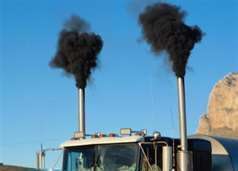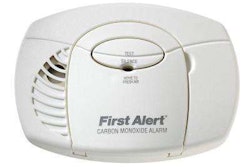
When it comes to the potential hazards of diesel exhaust, Randy Dunn, an owner-operator for Universal Am-Can, is unconcerned.
“Sometimes I have gotten out of the bunk with a headache from an exhaust leak, but the old timers say that’s about all it will do to you,” he says. “It won’t kill you.”
The old-timers are wrong. Though it takes a concentrated dose of carbon monoxide to kill you, prolonged exposure to small amounts can cause much more than headaches. Burning eyes, dizziness, labored breathing, chest pains, nausea, stiff joints, sleep disorders, and visual and mental impairment are among the symptoms attributed to poisoning from CO or certain other components of diesel exhaust.
Dunn, because he has always run older trucks, faces an above-average risk. Though it’s rare for deadly CO to leak into a truck cab, it can happen, especially as equipment ages. Furthermore, engines produced before October 2002 did not have to meet emissions standards as strict as today’s.
Experts differ on the degree of risk the average trucker faces by working around diesel exhaust. Much of this difference is due to insufficient or inconclusive testing of air quality at truck stops, say University of Minnesota air quality specialists. A Health Effects Institute study quoted on DieselNet.com notes that “information on ambient exposure [to diesel exhaust] is sparse.” Bill Fay, president of the National Association of Truck Stop Operators, says he would like to know if any studies point to such a problem. “The health of our employees and customers is a real concern to us,” Fay says.

Some experts compare the risk of exposure to diesel exhaust to that of getting lung cancer from second-hand cigarette smoke. Plenty of industry veterans, especially those who like to keep the ancient iron up to snuff, feel the same way. Dennis Steffler a 31-year over-the-road veteran who is now a Snap-On dealer, smiles when he remembers the old Detroit Diesel 318s and Big Cam Cummins, both noted for their smoke at start-up and when pulling a big load up a long hill.
“The old mechanicals would smoke until the turbo caught up with the fuel in the cylinder and gave it some air, especially when they were cold,” Steffler says. “Some guys would disable the aneroid or put a vise grip on the return line from the pump to get more fuel pressure. That made even more smoke.”
The advent of electronic engines put an end to such tricks and the black plumes that often accompanied them. Mandates from the U.S. Environmental Protection Agency continue to purify diesel emissions. The October 2002 deadline required heavy-duty diesel engines to emit no more than 2.5 grams of nitrous oxide and non-methane hydrocarbons, a reduction of nearly 90 percent from previous levels. The 2007 emissions requirements, aided by low-sulfur diesel standards beginning in 2006, will make diesel exhaust much cleaner.
Even with these improvements, no one is suggesting that you take deep drafts of exhaust into your lungs or continue to work in a cab you know to have exhaust leaking into it. Furthermore, you can protect yourself by following these practices:
- Consider generators or opti-idle technology to run air conditioning and heat. This will allow you to keep vents and windows closed.
- Be aware of weather conditions. Ozone, which is hazardous, forms on hot, sunny days when exhaust reacts with sunlight and tends to settle near the ground. Lack of a breeze allows ozone to hang in the air as night falls. Ozone is less likely to form in cold or cloudy conditions.
- Avoid spending prolonged time in a parking lot, shop or garage if a cloud of fumes is visible.
- If you break for walking or running while on the road, get away from the highway and truck parking lots.
- Put a CO monitor in your cab. They cost $30 to $40 at hardware stores and can be installed in minutes.
- Stop smoking. Combined with breathing diesel exhaust, smoking compounds your risk of developing lung and heart diseases.
The most severe problem with diesel exhaust occurs when it enters your cab and you breathe it long term. It can enter through open sleeper vents or partially opened windows, but the more common situation is a less noticeable leak that creates a highly carcinogenic atmosphere in which you continue to work and sleep.
Kip Jones, an owner-operator in the Baltimore area, says he was unaware of a leak he once had. “My eyes were burning, but I thought it was fatigue,” he says. “Then the floorboard got hot, and I knew there was a leak under there.”
Randall Packard left his over-the-road job last May due to CO poisoning. Packard says he continues to suffer from his exposure to CO, which occurred after a shop failed to correctly repair his exhaust. “I started getting headaches and needed to sleep 10 to12 hours a day. But it has gotten worse. The neurologist told me I needed a brain scan and other neurological tests. I continue to suffer with aching joints, a lack of interest in life, headaches.”
In general, truck makers follow the specifications for exhaust system integrity in the Federal Motor Carrier Safety Regulations. Derek Smith at Peterbilt notes that the FMCSR also details an inspection procedure for owners. And Jeff Parietti at Kenworth notes that exhaust is directed away from cabs by the exhaust pipes’ height and angle.
At Volvo, “We do humidity, duct and smoke tests,” says lead climate systems engineer Bob Hundley. One test involves setting off a smoke bomb in the engine compartment to determine whether air will leak into the cab. In addition, Volvo’s climate-control filters in the air intake and the sleeper remove 95 percent of ultra-small particulates.
Even though manufacturers perform these tests, owners should follow the federal guidelines for routine inspections. Beyond regularly checking your exhaust system for the tightness of clamps, joints and mounting brackets and visually inspecting the system for corrosion and wear, there are other equipment points to check:
MANIFOLD GASKETS. Ventilation systems can leak exhaust into the cab; sometimes worn gaskets are the source. Soot streaks are an indication you need a new manifold gasket. Check manifold bolt torque settings yearly.
FLEX TUBING. Exhausts repaired with flex tubing are more susceptible to developing leaks. Check monthly.
ENGINE COMPARTMENT. Electronic engines have fault codes to identify leaks. If you have a hand-held computer with the right software, you can check the engine control module yourself.
FILTERS. If your truck is equipped with cab climate control, change the intake and cab filter at recommended intervals.
DRIP TUBE. Because it hangs below the engine and emits oil and vapor directly from the engine, the drip tube can be the source when exhaust gets into the cab, says Ted Angelo of Donaldson Filtration Solutions. Donaldson sells a Spiracle CFS filter that helps reduce contaminants in drip tube emissions.
While experts debate precisely how much risk is involved, few deny that breathing fumes can cause serious health problems, often with long-term consequences. If you experience any of the symptoms of CO poisoning, consider evaluating your daily work environment, checking your cab for exhaust leaks and seeing a doctor.
THE WICKED STUFF IN EXHAUST
Diesel’s dangerous components include particulates and many gases known to be irritants and carcinogens.
“More than 40 substances [present in diesel exhaust] are pollutants,” says the American Lung Association website. It also warns that “exposure to diesel exhaust increases the risk of developing lung cancer and other non-cancer-related health problems.” The University of Minnesota website dedicated to environmental health concerns notes, “Diesel exhaust contains 20 to 100 times more particles than gasoline exhaust. These particles carry absorbed cancer-causing substances.”
While new oils have been created to trap particulates, and new standards created to limit them, some particulates still escape into the air.
Particulates may be visible as smoke or they may be so small as to be invisible, says the U.S. Environmental Protection Agency. The particulate matter standard, revised in 1997, now deals with particles in the 2.5 micron (1 millionth of a meter) range, down from 10 microns, often referred to as PM-10. The EPA’s AIRTrends website says, “Major concerns for human health from exposure to PM-10 include: effects on breathing and respiratory systems, damage to lung tissue, cancer, and premature death. People with chronic lung disease, influenza or asthma are especially sensitive to the effects of particulate matter.”
The smaller particles are often the most harmful because they are more easily inhaled and more easily lodge in lung tissue. Some ultra-fine particles leave the lungs and migrate to the brain, where they remain, says Dr. Jack Lebeau of Philadelphia, an expert on the effects of diesel exhaust.
Exhaust gases, too, pose problems. “Not all the gases in diesel exhaust are carcinogens, but those that are not are irritants, and others are especially harmful for people with pre-existing conditions like emphysema, heart disease and the inclination to have strokes,” Lebeau says. “And smokers who inhale exhaust are many times more likely to develop lung cancer.”
Among these gases are carbon monoxide, perhaps the most dangerous gas in diesel exhaust. Dr. David Penney, a toxicologist at Wayne State University, says there is much more CO in diesel than in gasoline exhaust because cars are equipped with catalytic converters that filter out CO.
“Exposure to elevated levels of CO is associated with visual impairment, reduced work capacity, poor learning ability and difficulty in performing complex tasks,” says the EPA website.
Lebeau adds, “CO is a killer at higher concentrations. It can cause unconsciousness and death in minutes.” At lower concentrations it can cause headaches, stiff joints, sleep disorders and disorientation. Penney says he has received thousands of calls from people, including dozens of truck drivers, who believe they are suffering from CO poisoning.
In addition, ozone is formed when sunlight comes in contact with oxides of nitrogen. Ozone is ground-level smog of the sort you see and smell in truck parking lots. According to the EPA website, “Exposure to ozone for six or seven hours, even at relatively low concentrations, significantly reduces lung function and induces respiratory inflammation in normal, healthy people during periods of moderate exercise.”
Other exhaust gases are nitric oxide, which is extremely toxic; nitrogen dioxide, a respiratory irritant; formaldehyde and benzene, which are carcinogens; and sulfur dioxide, hydrogen sulfide and carbon dioxide, all known to have harmful effects at high concentrations.
THE DIET STRATEGY
The right nutrients can help mitigate the effects of air pollution, says Dr. Ed Rendell, director of the Human Performance Lab at Marywood University in Scranton, Pa.
“A healthy diet helps,” he says. “Even more protection is available from dietary supplements.”
Rendell believes antioxidants and other supplements keep free radicals, formed when a pollutant enters the body and attaches to a molecule, from attacking the cell that contains the molecule.
Little is known about the effect of megadoses of antioxidants. However, they are considered by many doctors to be effective in fighting the onset of disease, including cancer and heart disease.
Antioxidants are abundant in fruits and vegetables. Vitamins C and E and betacarotene are antioxidants found in foods. Others include pycnogenol, CoQ10, selenium, quercetin and alpha lipoic acid. These antioxidants are found in efficient dosages only as supplements.
Many people have taken high doses of pycnogenol and other supplements for years without ill effects. However, vitamin C, betacarotene and perhaps other supplements can be harmful at high dosages. Consult a physician before beginning a supplementation program.










